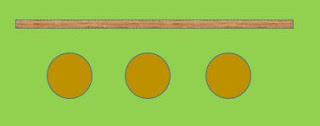This is a popular image demonstrating the difference between equality and equity (with equity implicitly the more desirable outcome). Think about something though. What does equity mean without measurement? It's easy in the picture because we can see it, height is easily gauged by visual inspection. But what happens if we don't know anything about height, either of the kids or the fence they all want to see over?
To get a sense of the problem, imagine if we could only see the kids from above:
Without height, all we see are the tops of three heads and the fence in front of them. How do we know who needs more resources and who needs less? How do we know who can see over the fence? Without the ability to measure height we can't answer any of those questions. We could make some kind of guess and move resources based on that, but we wouldn't know if we were improving equity or diminishing it. In the absence of measurement equity is impossible, even if we got lucky and lined up everything perfectly no one would know it.
I bring this up because measurement in at least one area, education, is a highly contentious issue. Opposition to testing is a mainstream movement in Portland, even promoted by School Board members. Not infrequently, those people also claim to be concerned with equity.
Any test can be improved, and any process informed by tests can be improved. But categorically rejecting testing, which seems to me the heart of the anti-testing movement, simply isn't compatible with a commitment to equity. Without testing policy is necessarily blind, and equity nothing more than a good but meaningless intention.

